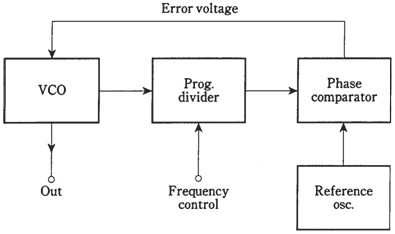The PLL frequency synthesizer
One type of oscillator which combines flexibility of a VFO with stability of a crystal oscillator is called as a PLL frequency synthesizer. This scheme is used extensively in modern digital radio receivers and transmitters.
The output of a VCO is passed by a programmable divider, a digital circuit which divides the VCO frequency by of hundreds or thousands of numerical values chosen by operator. The output frequency of programmable divider is locked, by a phase comparator, to signal from a crystal-controlled reference oscillator.
As long as output from programmable divider is the reference oscillator frequency, the 2 signals are in phase, and the output of phase comparator is zero volts direct current. If the VCO frequency begins to drift, the output frequency of programmable divider will drift, too. But even the tiniest frequency change—a fraction of 1 Hz—causes phase comparator to produce a direct current error voltage. This error voltage is positive or negative, depending upon whether the VCO has drifted higher or lower in the frequency. The error voltage is applied to a varactor in VCO, causing VCO frequency to change in the direction opposite to that of drift. This forms a direct current feedback circuit which maintains the VCO frequency at a precise multiple of reference-oscillator frequency, that multiple having been chosen by programmable divider. It is a loop circuit which locks the VCO onto a precise frequency, by means of phase sensing, thus the term phase-locked loop (PLL).
The key to stability of PLL frequency synthesizer lies in the reference oscillator is crystal-controlled. A block diagram of such a synthesizer is shown in the figure given below. When you hear that the radio transmitter, receiver, or transceiver is synthesized, it means that the frequency can be determined by a PLL frequency synthesizer.
The stability of the synthesizer is enhanced by using an amplified signal from National Bureau of Standards, which is transmitted on shortwave by WWV at 5, 10, or 15 MHz, taken directly as reference oscillator. These signals are frequency exact to a minuscule fraction of 1 Hz, as they are controlled by the atomic clocks. Most people do not require precision of this caliber, so you will not see consumer devices like ham radios and short wave receivers having primary-standard PLL frequency synthesis. But it is used by some corporations and government agencies, like military.

Figure-- Block diagram of a PLL frequency synthesizer.